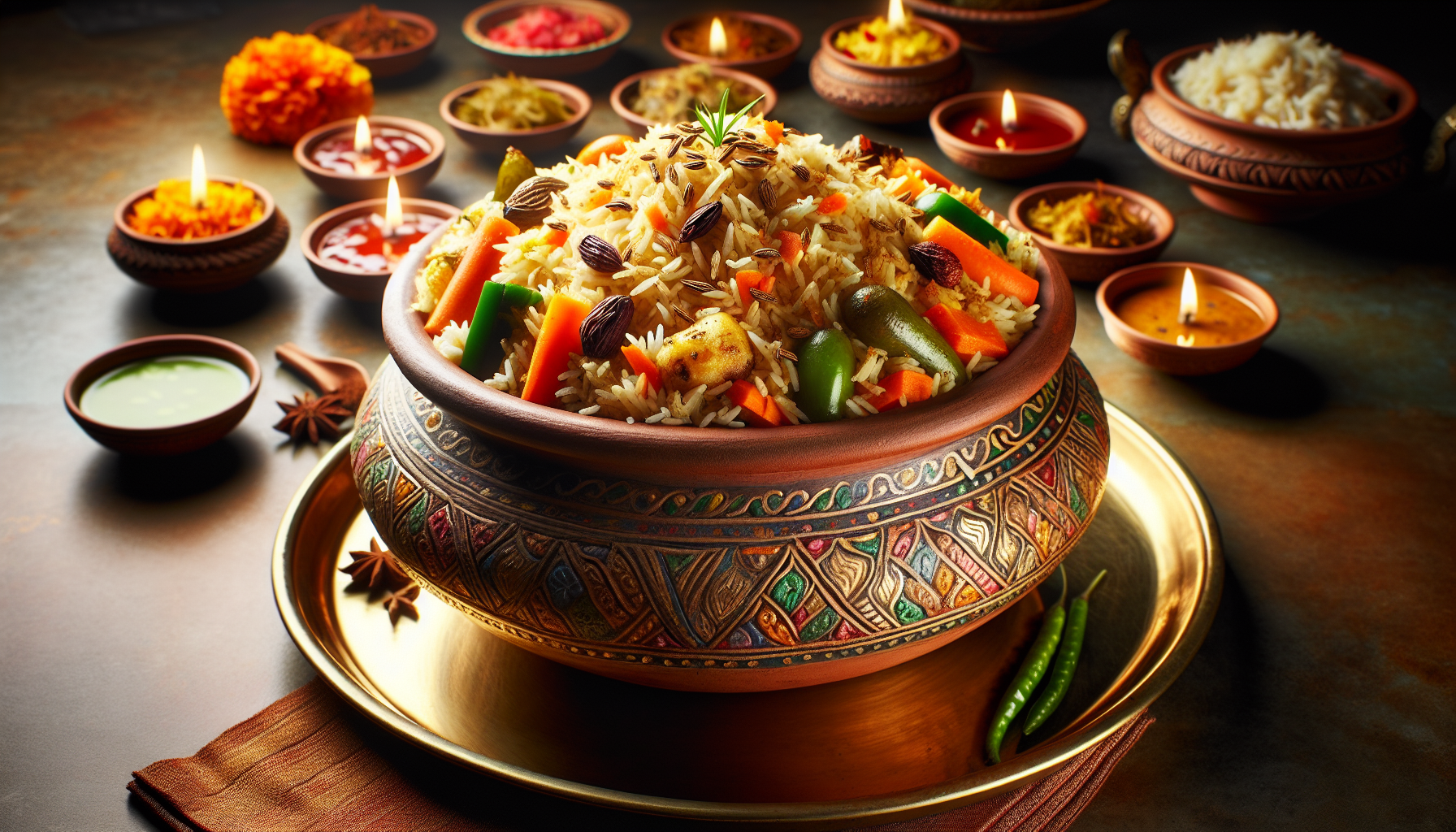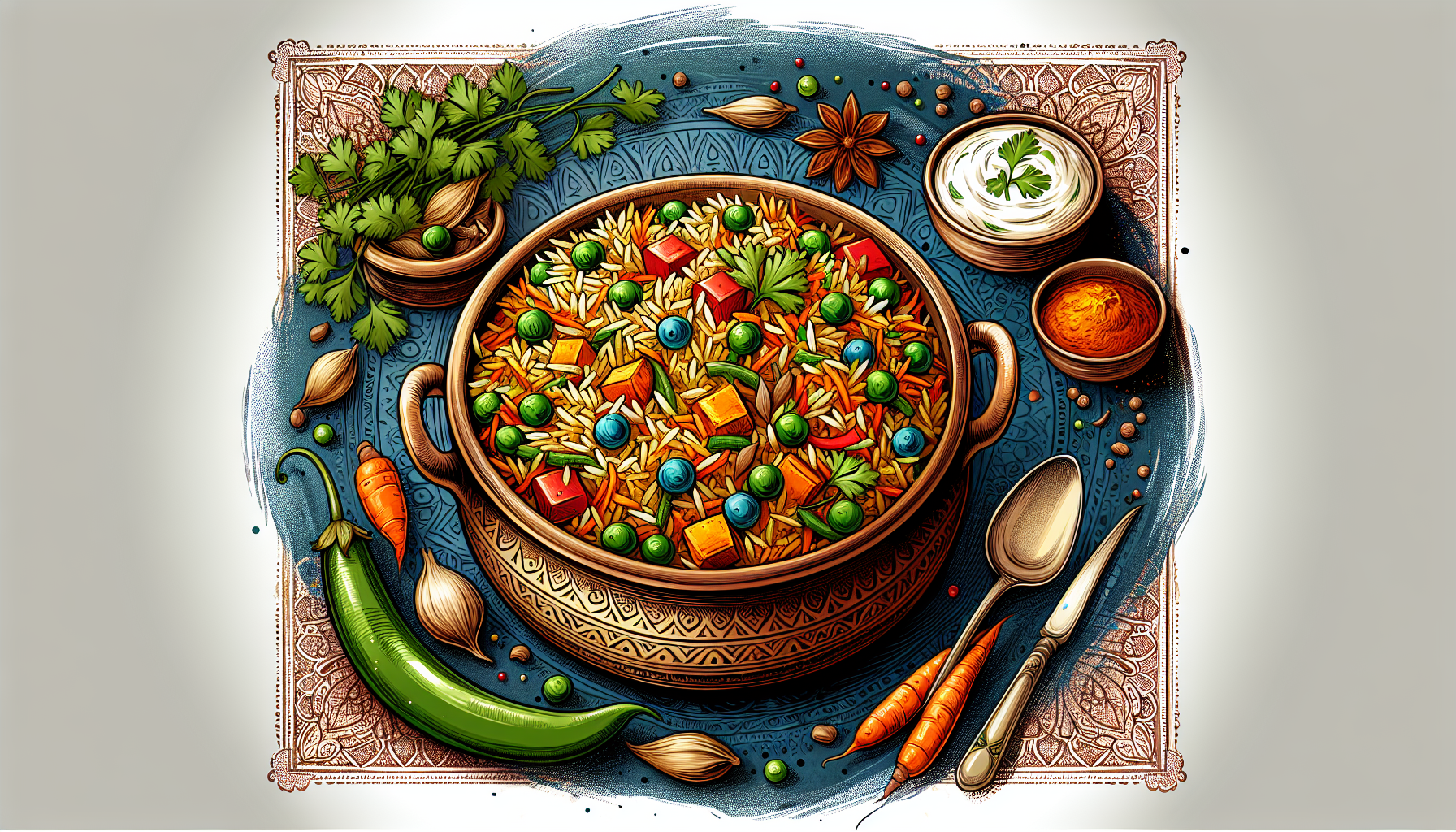Celebrate the festival of lights with a mouthwatering treat – Solo-Serving Vegetable Biryani! This traditional Diwali delicacy is bursting with fragrant spices, aromatic basmati rice, and a generous assortment of fresh vegetables. In this article, you’ll find a detailed step-by-step recipe that will guide you through creating this flavorful dish from start to finish. Get ready to impress your taste buds and loved ones with this delectable masterpiece!

Ingredients
Rice
One of the main ingredients in vegetable biryani is rice. You can use any long-grain rice for this recipe, such as Basmati rice. Make sure to wash the rice thoroughly before cooking to remove any excess starch.
Vegetables
Vegetables are the star of this dish. You can use a variety of vegetables such as carrots, peas, bell peppers, cauliflower, and potatoes. Feel free to add or substitute any vegetables according to your preferences.
Spices and Seasonings
To bring out the aromatic flavors in the biryani, you’ll need a combination of spices and seasonings. Some common spices used in vegetable biryani include cinnamon, cardamom, cloves, cumin, coriander, turmeric, and red chili powder.
Ghee or Oil
To cook the biryani, you’ll need some type of fat. Traditionally, ghee (clarified butter) is used for its rich flavor. However, you can also use oil as a substitute.
Nuts and Raisins
Adding nuts and raisins to the biryani gives it a delightful crunch and sweetness. You can use cashews, almonds, or any other nuts of your choice.
Saffron
Infusing saffron in the rice will provide a beautiful yellow color and a subtle floral flavor. You’ll need a pinch of saffron strands soaked in warm milk for this.
Yogurt
Yogurt is an essential ingredient in biryani as it helps in tenderizing the vegetables and adds a tangy flavor to the dish. Make sure to use plain yogurt without any added flavors.
Onions
Onions are used in two different ways in vegetable biryani. Dicing some onions and frying them to a golden brown will give your biryani a delicious caramelized flavor. You’ll also need finely chopped onions to cook with the vegetables.
Ginger and Garlic
The combination of ginger and garlic adds a wonderful depth of flavor to the biryani. You can either crush ginger and garlic together or make a paste using a mortar and pestle.
Others
Apart from these main ingredients, you may also need some other items like fresh cilantro leaves, mint leaves, and green chilies for garnishing, as well as salt and water for cooking.
Preparation
Soaking Rice
Start by rinsing the rice under cold water until the water runs clear. Then, soak the rice in water for about 30 minutes. This will help in achieving perfectly cooked, fluffy rice.
Preparing Vegetables
Peel and chop the vegetables of your choice into bite-sized pieces. If using potatoes, make sure to parboil them separately to ensure they are tender and cooked through.
Frying Nuts and Raisins
In a small pan, heat some ghee or oil. Add the nuts (cashews and almonds) and raisins. Fry them until they turn golden brown. Remove them from the pan and set aside for later use.
Infusing Saffron
Soak a pinch of saffron strands in warm milk and set it aside for a few minutes until the milk turns yellow. This saffron-infused milk will be used later to give the biryani a beautiful color and flavor.
Dicing Onions
Take one or two onions, depending on the quantity of biryani you are making, and dice them into small pieces. Keep aside a handful of diced onions for frying and finely chop the rest.
Ginger-Garlic Paste
Crush equal parts of ginger and garlic using a mortar and pestle to make a paste. Alternatively, you can also use a food processor to blend them into a smooth paste.
Chopping Other Ingredients
If you choose to use fresh cilantro leaves, mint leaves, or green chilies for garnishing, make sure to chop them finely.
Cooking the Biryani
Boiling Rice
In a large pot, bring water to a boil. Drain the soaked rice and add it to the boiling water. Cook the rice until it is about 70-80% done. It should still have a slight bite to it. Drain the rice and set it aside.
Preparing Biryani Masala
In a separate pan, heat some ghee or oil. Add the diced onions and cook until they turn golden brown. Add the ginger-garlic paste and sauté for a minute until fragrant. Then, add the chopped vegetables and cook them for a few minutes until they start to soften.
Next, add the spices and seasonings such as cinnamon, cardamom, cloves, cumin, coriander, turmeric, and red chili powder. Mix well to coat the vegetables with the spices. Finally, add the finely chopped onions and cook until they become translucent.
Layering the Biryani
Take a deep, oven-safe dish or a biryani pot. Start by layering half of the partially cooked rice at the bottom of the dish. Sprinkle some biryani masala and saffron-infused milk over the rice. Add a layer of the cooked vegetables, spreading them evenly. Repeat the layers with the remaining rice, masala, and saffron-infused milk.
Cooking the Biryani
Cover the dish tightly with aluminum foil or a lid to trap the steam. Place it in a preheated oven at 350°F (180°C) and bake for about 25-30 minutes. If you don’t have an oven, you can also cook the biryani on low heat on the stovetop for 20-25 minutes.
Garnishing and Serving
Once the biryani is cooked, remove it from the oven or stovetop. Let it rest for a few minutes before removing the foil or lid. Garnish the biryani with the fried nuts and raisins, as well as the fresh cilantro leaves, mint leaves, and green chilies. Serve the vegetable biryani hot and enjoy!
Tips and Variations
Vegetable Options
Feel free to customize the vegetable biryani by adding or substituting different vegetables according to your taste. You can include mushrooms, green beans, broccoli, or any other vegetables of your choice.
Spice Level Adjustment
Adjust the spice level according to your preference. If you like it mild, reduce the amount of red chili powder and green chilies. For extra heat, you can add some crushed black peppercorns or chili flakes.
Garnishing Options
Apart from the traditional garnishes mentioned above, you can also add fried onions or grated cheese on top of the biryani for an extra flavor boost.
Serving Suggestions
Vegetable biryani is a complete meal on its own, but you can serve it with raita (a yogurt-based side dish), papadums, or a salad for a well-rounded meal.
Storage and Reheating
If you have any leftovers, store them in an airtight container in the refrigerator. Vegetable biryani can be reheated in the microwave or on the stovetop. Add a little water to the biryani before reheating to prevent it from drying out.

Conclusion
Vegetable biryani is a delightful Indian dish that is perfect for any occasion. With its aromatic flavors, colorful presentation, and wholesome combination of vegetables and rice, it is a dish that will impress both your family and friends. Follow this comprehensive recipe, adjust the ingredients to your liking, and enjoy a homemade vegetable biryani that is sure to satisfy your taste buds. Happy cooking!
